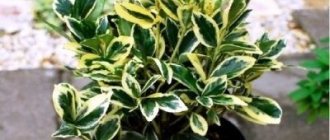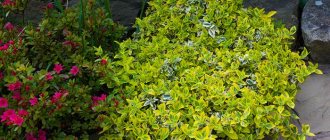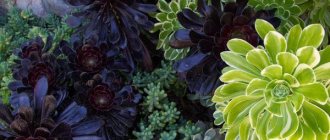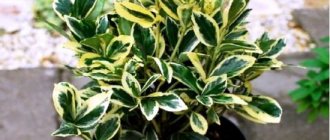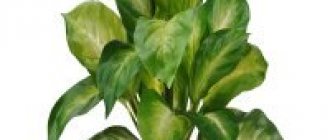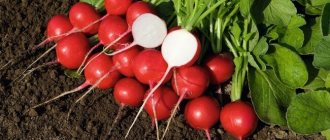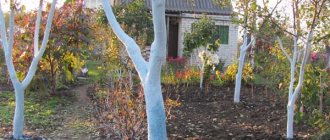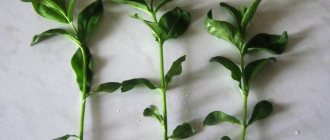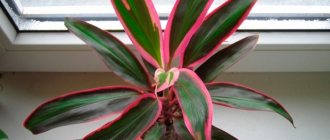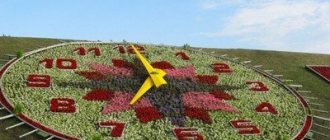The Euonymus plant is part of the Euonymus family. This genus, which includes more than 200 species, is represented by low deciduous and evergreen woody plants. Under natural conditions, such a plant can be found in Asia, America, Europe and Australia. This shrub is widespread throughout the Northern Hemisphere, preferring to grow in floodplains, valleys and the undergrowth of mixed forests. The scientific name of euonymus translated from Latin means “glorious tree” or “tree with a good name.” Among the Slavs, this plant has a large number of names, namely: lady's eyes, burusklen, kislyanka, lingonberry, privet, wolf's earrings, blind hen, night blindness, bruslina, meresklet, dereskled, heather, wolf's bast and saklak.
Most species of euonymus are cultivated as ornamental plants. For example, in landscape design they are used to decorate fences or outbuildings. In a garden plot, a hedge is often created from euonymus, and it looks very decorative both in the summer and autumn months. Species such as European euonymus and warty euonymus are used not only for decorative purposes, but also for the extraction of gutta-percha, which is contained in the shoots, as well as in the bark of the plant.
Brief description of cultivation
- Landing . At the very beginning of the spring period or in the fall, during leaf fall.
- Illumination . Green-leaved species grow well in partial shade, while variegated ones need a lot of bright light.
- Soil . It should be slightly alkaline or neutral, light, nutritious and well permeable to water.
- Watering . Moisten the soil only when necessary. If it rains regularly during the growing season, then the euonymus will not need watering.
- Fertilizer . Fertilizing is carried out in early spring and autumn, using complex mineral fertilizer.
- Trimming . At the beginning of spring or after fruiting is completed, both sanitary and formative pruning is carried out. The crown can be given a conical or ellipsoidal shape.
- Reproduction . By seed method, as well as by cuttings, dividing the bush or layering.
- Pests . Spider mites, mealybugs, caterpillars and aphids.
- Diseases . Powdery mildew and trunk rot.
Care and cultivation of climbing euonymus
The plant grows well in partial shade or sunny areas. Variegated forms look most decorative when grown in the sun, because in the shade the leaves acquire a greener color. Varieties with white leaves are planted in the shade, because white leaves can burn in the sun. It develops best on loose, fertile soils with a slightly alkaline or neutral reaction.
Climbing euonymus is watered abundantly, but moisture is not allowed to stagnate. During the summer (from May to September) complex mineral fertilizers are applied approximately 1-2 times a month.
Types of climbing euonymus are not highly winter hardy and therefore require winter shelter. Young plants especially need shelter. Spruce branches, dry leaves or any non-woven material are used as covering material.
In spring, sanitary and formative pruning is carried out. The plant is provided with support, while the branches are directed upward along the support from time to time.
Features of euonymus

The cross-section of euonymus stems can be round or tetrahedral; cork growths can form on their surface. Some species growing in nature can reach a height of about four meters. Opposite glossy simple leaf plates, jagged along the edge, are painted in a dark green hue. However, in some varieties, the surface of the foliage is decorated with specks of white, silver or cream, and they can be located along the edge of the plate or in its center. During flowering, the bush produces flowers of a creamy, greenish-yellow or burgundy hue; they are inconspicuous and do not have a very pleasant aroma. Flowers of 4 or 5 pieces are collected in corymbose or racemose inflorescences. The fruit is a leathery and dry capsule, which can be four- or five-lobed, as well as winged or spiny, with seeds inside it. During ripening, depending on the type, the fruit turns scarlet, burgundy, dark purple, pink, crimson or yellow. The stems of such a plant have a rich color. All parts of the plant, including the fruits, contain poison!
Euonymus Fortune
Popular varieties and types of euonymus with photos
Winged euonymus (Euonymus alatus) . The most important decorative element of this species is the fiery color of the autumn foliage, for which the plant received another name “burning bush” or “burning bush”.
It is a slow-growing, dense and wide shrub up to 2 m in height with rigid, highly branched, brown or greenish straight shoots.
The surface of the shoots is covered with longitudinal, ribbed, corky growths resembling wings, which is why the plant received the name “winged”. During the summer, the leaves remain green, and in early September, literally within a week, they become intensely scarlet. It seems that there is a fire bush blazing in the garden.
Variety "Compact"
The flowers have no decorative value, but the fruit stems are purple-red, standing out brightly on the bare shoots with the arrival of winter.
“Compact” is the most famous variety of this species with a rounded compact crown and a height of up to 1 meter. Its leaves change color to different shades of red in autumn.
“Fireball” - multi-colored autumn foliage, the height of the variety is about 1.5 meters, the crown is spherical, compact.
"Rudi Haag" - an extremely low, dwarf variety, up to 0.6-1 m high, with wider “wings” on the shoots and very slow growth.
European euonymus or bruslin (Euonymus europaeus) . It is a tree in the form of a tall bush. The leaves are dark green, and there are also variegated varieties. In autumn they change color to bright red.
Although this species is not widespread in gardens, it certainly deserves more attention due to its very decorative bright pink or red fruits and colorful autumn foliage.
The most famous variety, “Red Cascade,” owes its name to the leaves, which turn crimson with the onset of autumn.
Fortune's euonymus (Euonymus fortunei) . Probably the most decorative and widely cultivated evergreen ground cover species with a huge number of varietal forms and varieties.
Caring for Fortune's euonymus is slightly different from other garden species, mainly due to its growth form, which is characterized by creeping shoots with shiny, leathery leaves.
Popular varieties and varieties differ in foliage color and height. Let's list the most interesting of them.
"Emerald'n'Gold" (Emerald and gold). A bright, low-growing bush that is often used in garden landscaping. In cold winters, the golden-emerald leaves take on a pinkish tint.
'Emerald Gaiety' is a wide bush with dark green leaves and a wide white edge.
"Sunspot". A small bush up to 30 cm in height with shoots that spread along the ground, forming an attractive yellow-green carpet. The leaves are green with a bright yellow or cream spot in the middle of the leaf. In winter they take on a red tint. Does not require any pruning.
'Harlequin' is a compact, slow-growing shrub with variegated green and creamy white leaves that turn pink in autumn.
"Sunshine" is a shrub up to 70 cm in height and up to a meter in width. Bright yellow leaves with a green center. It lends itself well to pruning, which allows you to form a compact, rounded crown.
'Silver Queen' is a popular and highly decorative form with variegated white and green foliage. Its long shoots, reaching 6 meters, can easily trail along the support.
"Silverstone" is a beautiful dwarf shrub 30 cm tall with semi-erect shoots and green-white spotted leaves.
Japanese euonymus . Mainly cultivated as a houseplant. It is characterized by narrow, leathery leaves that can reach 7 cm. The shrub is sensitive to cold and requires protection in winter.
“Microphyllus” is very similar in appearance to boxwood and is also easy to form a crown.
'Bravo' has green and creamy yellow variegated leaves. 'Golden Queen' with broad golden-yellow foliage. "Katie" with variegated white and green leaves.
Variety "Silver King" with a compact crown and variegated green and white foliage.
"Aureomarginata" is a variegated variety with green leaves and a white-yellow border along the edges of the leaf.
Planting euonymus in open ground

What time to plant
Euonymus takes root best after planting in early spring, but this plant can also be planted in open ground in the fall. It will be better for the shrub if it is in slight shade, but for variegated varieties it is better to choose a sunny area. The soil on the site can be neutral or slightly alkaline, light, rich in nutrients and well drained. If the soil in the area is acidic, it can be corrected by liming, which is carried out before planting the plant.
In addition, when choosing a site, it is necessary to take into account the fact that euonymus reacts extremely negatively to high groundwater levels. You should also remember that the bush grows quite strongly in width, and some species grow in height. In this regard, when planting a plant, maintain the recommended distance between the bush and a building or other plant. If you decide to cultivate dwarf species of such shrubs, then it is better to use large pots or boxes for planting them. In the summer, such an euonymus is kept in the garden, and in late autumn it is transferred to an unheated cool room for the winter. In this case, the same bush can be considered both a garden and indoor crop.
Landing Features
You need to prepare a hole for planting no later than half a month before planting the seedling. Its volume should be 1.5 times the plant’s root system. When preparing a hole, the top layer of soil is not thrown away, but combined with compost. At the bottom of the planting pit, make a layer of drainage using broken brick or sand. The drainage is covered with a small amount of soil mixed with compost. If the soil on the site is acidic, then 0.2 kg of lime is poured into each hole, which is first slaked and then combined with soil and compost. Place the bush in the planting hole and carefully straighten its root system. Fill the hole with soil mixed with compost, and you need to fill it up gradually, regularly compacting the soil mixture so that there are no air pockets left in the hole. After planting, check that the root collar is flush with the surface of the area. If you decide to create a hedge from euonymus, then it is better to make a trench for planting rather than a hole. The planted bush needs to be watered well. Moisten the soil every day for a week.
Euonymus planting and propagation in autumn
Description of euonymus
Sometimes the height of this plant reaches 4 m. The foliage is dark green, shiny, sometimes with creamy-silver spots in the center. Flowers with a not very pleasant smell, they are collected in inflorescences and brushes. It bears poisonous fruits; other parts of the plant should also not be eaten. You can view photos of all types of euonymus and descriptions on our website.
1
4
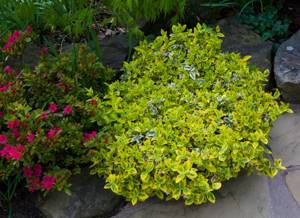
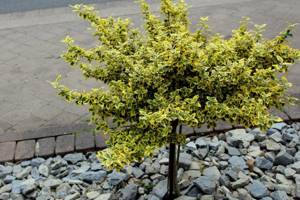
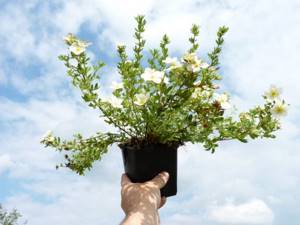
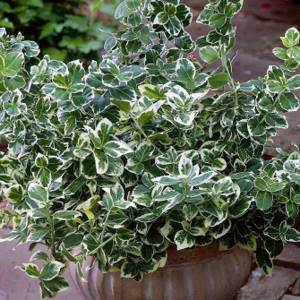
If you have chosen euonymus for your garden plot, you need to know that it is planted in early spring, sometimes in autumn. Don’t forget to carefully study the euonymus, learn about the planting features, and look at photos of the process. He likes to be in partial shade; the soil should be fertile, with good water permeability, and light. An important point is that the plant grows greatly in width and sometimes in height, so it should be planted away from trees, ensuring sufficient distance between the bushes and buildings on the site. Indoor varieties are planted in large pots and boxes; in summer it is better to leave them outside, and in winter they need to be brought into the house.
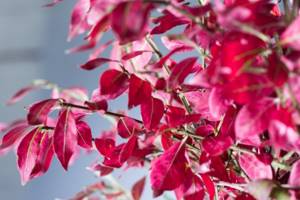
Euonymus with pink leaves looks amazing!
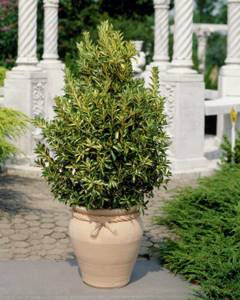
Euonymus can be grown in a pot
It is necessary to prepare a hole for planting plants in advance, about two weeks in advance. Make sure that the volume is 1.5 times greater than the root system of the seedlings. Place sand or a special composition for drainage at the bottom of the hole, cover with a layer of compost mixed with soil, then lower the plant seedling, straightening the roots, cover with a mixture of soil and compost, lightly tamping it down. If the euonymus will serve as a hedge, it is better to plant it in a trench. Naturally, after planting the plants, water them and do not forget to do this during the first week.
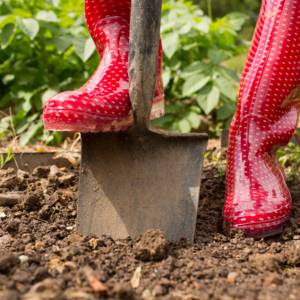
Preparing a hole for planting euonymus
Euonymus care

Watering
Water the euonymus only when necessary. To make caring for it much easier, cover the surface of the tree trunk circle with a layer of mulch (dry soil), and this should be done immediately after watering. During the season, loosen the soil surface in the tree trunk circle at least three times; this procedure is carried out 1–2 days after watering. If the summer is not dry and it rains systematically, then there is no need to water the plant. Remember that stagnation of fluid in the root system is very harmful to euonymus.
Fertilizer
In order for the shrub to develop and grow normally, it must be fed twice during the season, namely: in spring and in autumn. For this purpose, complex mineral fertilizer is used.
Trimming

Euonymus needs regular pruning, thanks to which the bush begins to branch much more strongly, which has a positive effect on its decorative effect. Remember that in most species of this plant the fruits are considered decoration. That is why it is recommended to prune the bush in order to form a crown at the very beginning of spring or at the end of fruiting. During the growing season, only sanitary pruning is carried out: shoots that thicken the crown are removed, damaged and weak stems are cut out, and the upper parts of the branches are also pinched. Formative pruning allows you to give the crown an ellipsoidal or conical shape. Quite often such a plant is formed in the form of a standard tree.
Diseases and pests

Most often, mealybugs, caterpillars, aphids, and spider mites settle on the bush. Spider mites and aphids feeding on plant sap cause pale silver dots to appear on the leaf blades at puncture sites. Over time, deformation of young shoots and foliage occurs. To get rid of these pests, the plant is sprayed 3 times with Actellik solution (1-2 milligrams per 1 liter of water). Treatments are carried out at intervals of 1 week.
If honeydew and cotton wool-like formations appear on the foliage of a bush, this means that mealybugs have settled on it. In this case, the euonymus is treated twice, using a solution of Confidor, Aktara and Fitoverm. The interval between treatments is 1–1.5 weeks.
It is recommended to tear off all nests of caterpillars that you see on a bush with your hands and destroy them with fire. An interesting fact is that if caterpillars settle on the euonymus, then there will definitely not be any on the nearby fruit trees. You might even think that the euonymus, trying to protect your harvest, “takes the blow” on itself!
Euonymus is quite resistant to diseases, but it can still develop trunk rot or powdery mildew. Trunk rot is classified as a dangerous fungal disease, which is extremely difficult to cure. It is much easier to prevent it from infecting the plant; for this purpose, preventive spraying of the plant is carried out in spring and autumn, and a solution of Bordeaux mixture (1%) or a product of similar action is used for this. All affected areas are cut out and destroyed. If the bush is very badly affected, then it can no longer be saved. In this case, it is dug up and burned.
Powdery mildew is also a fungal disease. In order to save the bush, it needs to be treated 3 or 4 times with a solution of a fungicidal drug, for example, Topaz, Previcur, Skor or Fundazol. The break between spraying should be 7 days.
Planting and caring for euonymus
Of course, each type has its own characteristics, but in general, caring for them is approximately the same. Euonymus have similar soil and watering requirements, but some species tolerate shade better, others less well. Therefore, you should familiarize yourself with the characteristics of the purchased variety and choose the most suitable place. Caring for an established plant will not be burdensome.
Important! Euonymus prefer soil with neutral acidity, so soil with high acidity must first be limed with slaked lime or dolomite flour.
Landing rules
Euonymuses look most vibrant in sunny areas, although most tolerate shade. It is recommended to choose a place for them in the sun or in light shade. The planting hole is dug out slightly larger than the container with the plant or its roots, if a seedling with an open root system is purchased.
Maintain the recommended distance between several bushes. Most tall species are placed 1.5 m apart from each other. When growing hedges, they are planted more closely together. Ground cover and dwarf species can be planted even closer. For example, fortune euonymus seedlings are planted at intervals of 30 cm from each other to obtain a fence.
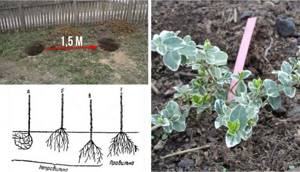
The best time for planting is spring (early March). Organic matter (humus, compost) and complex fertilizer are added to the planting hole along with the top fertile soil. Sand is added to the dense soil, and at the bottom of the hole, drainage is made from gravel up to 15 cm thick, since the crop does not tolerate stagnant water.
After planting, the plant needs to be watered and ensure that the root collar is flush with the ground. It is best to cover the trunk hole with mulch to maintain moisture.
Video: Planting and caring for euonymus

Euonymus propagation
To propagate euonymus, the seed method, dividing the bush, layering and cuttings are used. Variegated varieties, as well as those with yellow or red foliage, can only be propagated by vegetative methods.
Layerings

In spring, select those stems that grow very low relative to the soil surface. Make grooves in the ground under them and place the selected stems in them, which are fixed in this position and covered with earth. The roots of the cuttings grow very quickly. And when they are completely rooted, they can be separated from the mother plant and transplanted to a new permanent location.
Cuttings

To take cuttings, bushes older than 5 years are used. Cuttings are cut in June–July; for this purpose, the upper parts of semi-lignified stems are used. The length of the cuttings should reach approximately 70 mm, and each of them should have one internode. Treat the cut of the cutting with a product that stimulates root formation, after which it is planted in sand mixed with peat for rooting. Cover the cuttings with a transparent cap and place them in a cool, well-lit place. The cuttings will fully take root after 6–8 weeks, after which they are transplanted into a training bed in the garden and grown.
Euonymus cuttings. How to propagate by cuttings.
Root suckers
At the beginning of spring, immediately after the soil in the garden warms up, select the strongest root suckers, the height of which should be no more than 0.4–0.5 meters, and cut them off from the parent bush. The root length of the offspring should be from 25 to 30 centimeters, and its diameter should reach at least 15 mm. Dig up the shoot and, without removing the soil from the roots, either plant it in a permanent place or grow it to the desired size.
Dividing the bush
This method is perfect for propagating dwarf varieties. The fact is that their root system does not lie very deep, and every year they develop new root shoots. Take a sharp shovel and carefully cut off the root shoots, grabbing a small part of the rhizome, separating it from the parent bush. The shoots of the shoots are shortened by 2/3, after which the division is planted in a previously prepared hole in a new place. This procedure does not harm the plant, and it tolerates it quite well.
Seed propagation
In euonymus, freshly collected seeds are sown directly into open ground, and this is done in the autumn. In late autumn, crops are covered with a layer of mulch (straw or dry leaves). You can sow seeds in spring, but they need to be prepared. The seed material is subjected to long-term stratification; for this, it is placed on a refrigerator shelf for 6 months. However, before putting the seeds in the refrigerator, they are kept in water for two days.
Reproduction of climbing euonymus
Climbing euonymus is propagated by layering, cuttings or seeds. Propagation by layering or cuttings is considered the most effective. Cuttings are cut in June and July from young and healthy shoots. Cuttings about 7 cm long and with one internode are rooted in nutrient soil under glass or film. After the roots have formed, 1.5-2 months later, the cuttings are planted in open ground.
Propagation by layering is not particularly difficult; you just need to pin a branch to the ground and water it from time to time. Roots form where the branch touches the ground. Next spring or autumn, the cuttings are separated from the main plant and transplanted to a permanent place.
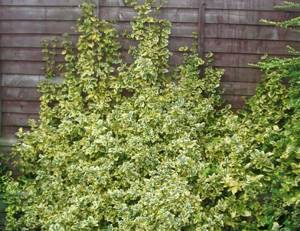
Euonymus in winter

Autumn care
Euonymus is quite simple and easy to care for both in spring and summer and in autumn. If this is necessary, then the collection of seed material begins only after the boxes crack. Immediately after this, you can begin sowing the seeds. To begin with, all the buds are removed from the seeds, and then they are pickled in a pink potassium manganese solution. Sow them in moist soil. Do not forget to cover the crops with fallen and dried leaves or straw.
Features of wintering
All bushes under 3 years old must be covered for the winter, as they can freeze. To do this, use fallen leaves or spruce branches. Adult plants are not covered for wintering, but if the winter months turn out to be little snow and frosty, its roots may suffer because of this. To prevent this from happening, cover the surface of the tree trunk circle with a layer of dry leaves or sawdust.
Winter hardiness
Dwarf euonymus has high winter hardiness (zone 4). Adult plants do not need shelter during the cold season. This does not apply to shrubs that are less than 5 years old. For the winter, they need to be wrapped in a fabric that allows air to pass through well, such as cotton. To retain heat better, you can also cover the plant with burlap.
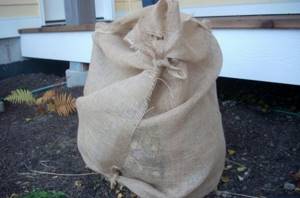
Types and varieties of euonymus with photos and names
In the wild you can find a large number of species of euonymus. Gardeners also cultivate many species of this spectacular plant. Below we will describe those species and varieties that are most popular in culture.
Euonymus verrucosa (Euonymus verrucosa)

Under natural conditions, such a plant can be found in the mountains of South-Eastern, Central and Southern Europe, as well as in the European part of Russia. The species is represented by shrubs (height about 2 m), as well as not very tall trees (height up to 5–6 m). The stems and branches are painted a rich green color, and on their surface there are many black warts. The color of the foliage is pale green, the flowers are light brown, and the fruits are pink, while the seeds are covered with brownish-red appendages. In autumn, this plant is most attractive: rich green stems are decorated with pink leaf plates. This species is slow-growing and is distinguished by its unpretentiousness and shade tolerance. It is quite common in culture, and it is often used to decorate a garden plot.
European Euonymus (Euonymus europaea)

This species grows in nature on any soil high on slopes, as well as in the deciduous forests of Asia Minor and Europe. It is represented by low trees (height about 6 m), most often it grows as a bush. While the stems are young, they are colored green, and corky longitudinal growths often form on them. Over time, the branches turn almost black. The leaf plates, leathery to the touch, have an obovate or ovoid shape, and are about 11 centimeters long. They are painted dark green, and in autumn they have a reddish tint. Ripe fruits become dark red or pink, and each seed is covered by an orange-colored apex. This species grows well in urban environments and is highly resistant to drought and frost. In autumn, this euonymus looks very impressive against the background of the usual golden-yellow leaves of other crops. There are more than twenty decorative forms of European euonymus, but they are less resistant to frost, for example: weeping, dwarf, aucubifolia, intermediate, purple, silver-spotted, etc.
Winged euonymus (Euonymus alata)

Under natural conditions, the species is found both singly and in groups in Japan, Southern Sakhalin, China and Korea. It prefers to grow in river valleys, on rocks, along mountain streams, and also in deciduous shady forests. The species is represented by highly branching shrubs (height about 2.5 m), as well as low trees. The branches are tetrahedral, they are covered with grayish bark. Leathery to the touch, dark green glossy leaf plates have a rhombic or obovate shape. The flowers are small, pale green, and are collected in bunches of 3. Ripe seed pods are colored deep red. This species has approximately 20 varieties and forms. The most widespread of them is the Compactus form: a not very large shrub, the height and width of which is no more than 200 centimeters, the crown is compact and dome-shaped, the flowers are inconspicuous. In autumn, the greenish oval leaf plates change their color to deep red, the fruits are red, and the pericarps are orange. Frost-resistant, but reacts negatively to too high temperatures and drought.
Fortune's euonymus (Euonymus fortunei)

The species is native to China. It is very popular in culture, and today it can be found in gardens in fairly cool regions. This species is very different from those described above. The agricultural technology for growing this plant is also significantly different from many euonymuses. This shrub is creeping and not upright. This species is also unique in that it is one of the few evergreen crops that can grow normally in mid-latitudes. In winter, the bush is completely covered with snow, which reliably protects it from frost. The elliptical-shaped glossy leaf plates are leathery to the touch and reach a length of about 40 mm; their edges are uneven and slightly curved. There are a large number of decorative forms that differ from each other in foliage color. These forms can only be propagated by vegetative methods. Best varieties:

- Gracilis . The length of the stems of such a ground cover plant is about 150 cm. The foliage is pale yellow, but after some time its edge becomes white, and the center plate turns red.
- Vegetus . Thick stems are decorated with large rounded leaf blades, as well as glossy yellowish seed pods.
- Emerald Gold . This shrub is characterized by very slow growth, its height does not exceed 50 cm, but its width can grow up to 150 cm. The length of the pale yellow variegated leaf plates is about 50 mm; on their edge there are streaks and spots of yellow color, which are arranged randomly. In autumn, the foliage changes its color to red.
Such a plant also needs to be watered, if necessary, loosen the trunk circle and cover it with a layer of mulch. Also, do not forget to trim it in a timely manner, while removing diseased, injured and weak stems, as well as excessively green shoots that are noticeably different from the rest characteristic of this variety.
Japanese euonymus (Euonymus japonica)

Only this species is grown in culture both at home and in open ground. It is a very close relative of the Fortune euonymus and in nature can reach a height of about 7 meters. The branches extend from the trunk at a not very large angle, giving the impression that the bush is directed upward. The dense, large leaf blades have a pointed tip at the top, they are leathery to the touch, and their edges are uneven. The foliage is dark green, and its edges are light in color. If you decide to grow this species, remember that it needs certain conditions. If you do not have the opportunity to create them, then at the beginning of the spring the bush will begin to grow actively, but after some time its growth will freeze. Under favorable conditions, the growth of the bush in 12 months is from 15 to 20 centimeters.
The best forms of this type:
- Mediopictus . The striking golden foliage has a green edge.
- Latifolius Albomarginatus . The green leaf blades have a wide white border.
- Macrophylla . The length of large sheet plates is approximately 70 mm.
- Aureo marginata . The foliage has a golden edge.
- Pyramidata . The shape of the bush is pyramidal, it is decorated with wide elliptical foliage.
- Microphyllus . The height of such a variegated plant is about 50 cm, and in diameter it reaches no more than 15 centimeters. Raised leaf blades are greenish-yellow. The flowers are white.
You need to care for such a plant in almost the same way as garden crops in the warm season, and in winter - like indoor flowers. It is recommended to grow this species in a large pot or box, since in late autumn it is transferred to a cool room for the winter. This plant may die when the air temperature drops to 5 degrees or below.
In addition to these species, gardeners also cultivate such as: alder-winged euonymus, dwarf, red-fruited, Koopman, Maak, Maksimovich, Sakhalin, sacred, broad-leaved, etc.
Types and varieties of euonymus
These beautiful shrubs of the genus of the same name from the Euonymus family are divided into different species, which can be deciduous and evergreen, growing upright and ground cover. Many of them look very beautiful in the fall due to their bright foliage and fruits. There are variegated varieties.
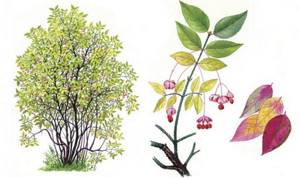
The plant has unusual fruits, similar to boxes with bright stipules. From a mix of different types of euonymus you can create interesting compositional groups. Sometimes common privet (for example, the Atrovirens variety) is mistakenly called euonymus, but this is a completely different, although somewhat similar, plant from the Olive family.
Video: Description and varieties of euonymus
Maaka
It grows in natural conditions in eastern Siberia, slopes by the sea, as well as the northeastern regions of China. The bush grows up to 3 m in height, the tree - 8 m. In autumn, this plant crop pleases with unusual pink fruit boxes and variegated purple-pink large oval-shaped leaves.
Did you know? 142 species of euonymus have been discovered in the world, growing mainly in the temperate zone and subtropics. In Russia, 20 of them can be found in natural conditions.
The Maak euonymus blooms in June in the form of small light flowers. The shoots often have a bluish coating. The bushes grow quickly, are unpretentious in care, frost-resistant and drought-resistant.
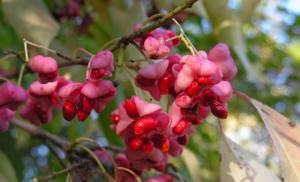
Japanese
Japanese euonymus is often planted in tubs, as it is quite heat-loving and does not tolerate frost well. Grows naturally in Japan, China and Korea. It is often used to design patios or terraces, but in the south it can also be grown as an outdoor plant. Its leaves are green or variegated in color.
The bush has oval-shaped leaf plates with a dense structure and produces fruits in the fall in the form of pink boxes with orange seeds. The height can be 2–8 m. The bushes bloom in May with small whitish flowers that emit a sour aroma.
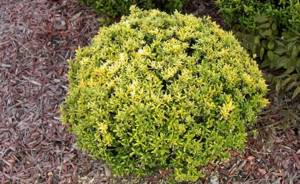
Among the varieties of this species, the most popular is the dwarf euonymus Microphyllus, which has small dark green glossy leaves and a height of no more than 0.5 m. It is used as a green fence and for arranging natural borders.
At the beginning of summer, small yellow flowers appear on it. There are also variegated varieties of this species. For example, the variety Ovatus Aureus with yellow-green foliage or the white-green variety Bravo.
Video: Japanese euonymus
Greatwing
Euonymus euonymus grows as a tree up to 9 m. Smooth shoots are green or dark purple in color. The leaves are 4–15 cm long and 2–8 cm wide, ovoid in shape. It blooms with small white buds in May-June.
In autumn, fairly large fruits appear in the form of dark crimson-colored boxes. Grows naturally in the Far East, Japan and China. It retains its decorative properties until frost.
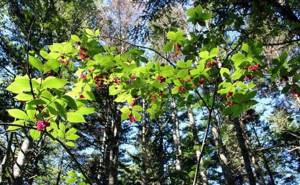
Groundcover Fortune
This type of plant crop grows in natural conditions in China. Fortune's ground cover euonymus is a bush that creeps along the ground. This creeping evergreen has pink-green leaves that are 4cm long and slightly curled. Flowering occurs in May in the form of white-green small flowers, then red-brown fruits ripen.
The Emerald Gold variety is quite famous, having a height of about 0.5 m and spreading 1.5 m wide. Its variegated foliage has a golden color. Another popular variety is Emerald Gaeti. This small-leaved ground cover bush reaches a length of up to 25 cm and has oval-shaped foliage with a white edge. In autumn it turns red-pink. The Minimus variety is also popular, growing up to 15 cm in height.
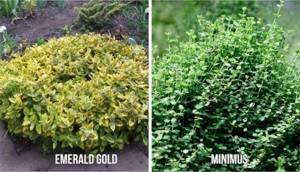
European
The European species is a shrub or small tree 2.5–8 m high, shedding leaves. The shoots have a green-brown color. The egg-shaped leaf blades, 3–7 cm long, are colored purple in autumn. It blooms from June to July, and the bright fruits ripen in August. They like to plant it along fences.
Important! Euonymus is a poisonous plant. It is recommended to wear gloves when working with it.
The wood of this plant crop is quite hard and holds fastenings well. Therefore, it is used as choppers for boots, keys, knitting needles and other small wooden products. From this shrub you can get a substance called fusain. It is used for drawing as it does not leave marks.
There are different varieties and forms of European euonymus. The Pendula variety has an unusual weeping crown, and Intermedia has a beautiful aesthetic shape thanks to its large dark pink fruits. There are also variegated (Aucubaefolia, Argenteo-variegata) and dwarf varieties (Nana).
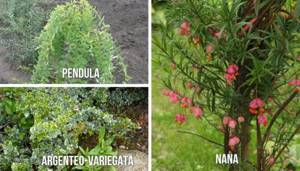
Warty or few-flowered
In Russia, warty euonymus (another name for few-flowered) is found in forests. This shrub generally grows up to 2 m in height, but in nature it can reach 6 m. There are dark brown growths on the shoots, similar to warts. This feature gave it its name.
In the last days, flowering begins in the form of beige-brownish flowers and lasts almost 4 weeks. Pink fruits appear in August and delight with their unusual appearance before the onset of cold weather. The shrub has superficial roots. The foliage is green in spring and turns reddish-pink in autumn.
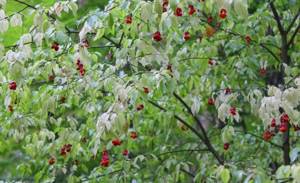
American
In America, this species is also called strawberry bush or “broken heart”. Its bushes grow up to 2 m and are quite frost-resistant. It has thin shoots, colored green or gray-brown.
In spring it blooms with small greenish or brownish-pink flowers located in the axils of the leaves. The finely serrated green leaves have a dense structure and an elongated oval shape. In autumn the foliage turns red and then falls off. The bush produces pink fruits in the form of boxes.
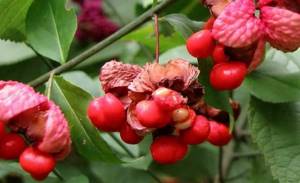
Wilson
This species can be found in nature in the western regions of China. This euonymus received its name in 1908 in honor of Ernest Wilson. Its main difference is the yellow color of the spherical seed pods, which gives the bush a beautiful aesthetic appearance. The leaves have a variegated green color.
Did you know? Euonymus' botanical name in Latin, Euonymus, comes from the Greek word meaning "good", meaning it can be thought of as a crop with a "good name".
Maksimovich
Maksimovich's euonymus grows in the Primorsky Territory, as well as in northeast China. It is found in coniferous forests and on coastal slopes among other bushes and trees. This tree grows up to 8m and has showy dark purple berries. Green foliage turns pink-red in autumn.
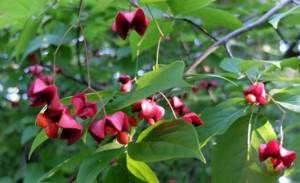
Sacred
Sacred euonymus is a shrub up to 1.5 m high. The shoots are covered with wing-like outgrowths about 0.5 cm wide, gray or brown. Leathery leaves up to 7–8 cm long have a diamond shape. From the beginning of the season they have a lush green color, and in the fall they turn purple.
It has spherical fruits of a dark red color. Flowering occurs in May with inconspicuous flowers about 1 cm in diameter. The species is well suited for group compositions, as it harmonizes well with other shrubs and trees.
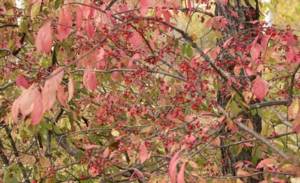
Koopman
This evergreen, creeping shrub grows up to 1 m. It has ribbed shoots with elongated leathery green foliage up to 5 cm long. The leaves have a bluish tint below and are shiny at the top.
The branches spread along the ground and quickly take root upon contact with it. Flowers measuring about 5 mm are greenish in color and appear in late May. In autumn, the bush produces fruits in the form of boxes with 4 pink lobes.

Winged
Cultural forms of winged euonymus grow 2–3 m high. Green shoots bend towards the soil and have a tetrahedral cross-section. They have growths similar to wings. Blooms in simple inflorescences of 1–3 flowers.
The fruit buds in the form of a small orange-red box. Green shiny leaves 3–7 cm in size turn red in autumn. A low-growing variety Compactus has been developed, growing up to 1.5 m.
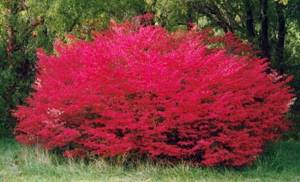
Sakhalin
The Sakhalin euonymus came from the Far East. This is a bush 2–3 m high with spreading branches. Large oval leaves up to 11 cm in length are attached with petioles of 5–12 cm. It blooms in June-July in inflorescences with 5–15 flowers. Green foliage turns bright red in autumn. After flowering, dark pink capsule fruits measuring 10–15 mm are formed.
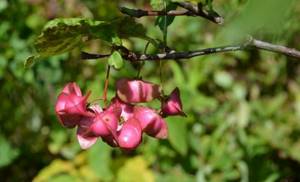
Properties of euonymus

All parts of the euonymus contain poison, but despite this, it is widely used in alternative medicine. The foliage, seed pods and wood of this shrub have healing properties. They include organic acids, tannins, sucrose, pectin, carbohydrates, steroids and vitamin C, as well as fatty acids (oleic, linoleic), alkaloids, flavonoids, gutta, etc.
Infusions and decoctions prepared from this plant are distinguished by laxative, antiparasitic, antiemetic, antispasmodic and choleretic effects. In case of an overdose, inflammation of the intestines occurs, vomiting and nausea occur, and the pulse slows down. Products made from euonymus should not be taken by people with heart failure and bradycardia, and they are also harmful to pregnant women. But even if you are relatively healthy, it is still recommended to consult a qualified specialist before using such a product for the first time.
GARDEN euonymus, PLANTING, WATERING, CARE,
Growing and care
These euonymuses prefer fertile and slightly alkaline soils and do not like stagnant moisture. If the soil on the site is acidic, then lime should be added. Open areas are selected for planting, because in the shade the decorative qualities of variegated varieties are reduced. However, if the sun is too bright, the leaves become dull and their edges curl. Plants are usually planted in spring in groups, at a distance of 50-70 cm from each other. During the period of active growth, fertilizing with complex fertilizer is very useful, but at the end of summer they are stopped in order to slow down growth and allow the bushes to better prepare for winter.
Euonymuses are well trimmed, so their crown is often shaped in the form of a ball, cone or ellipse. The pliability and flexibility of Japanese euonymus shoots allows them to be used in the formation of bonsai culture.
Use of euonymus warty: benefits and dangers of the plant
Euonymus has long attracted human attention not only with the beauty of its leaves and fruits, but also with its beneficial qualities. In the West, this deciduous shrub is called nothing more than “spindle”. The reason for this nickname is quite prosaic. Since the Middle Ages, peasants have turned spindles for spinning wool from light, durable euonymus wood.
And already at the beginning of the last century, gutta was discovered in the thickness of the bark of the euonymus - a rubber-like substance, from which, before the discovery of synthetic plastics, electrical insulating materials, parts of devices for the chemical industry, consumables for the shoe industry and medicine were made. Today, the need for this substance has disappeared, but scientists decided to carefully consider the chemical composition of not only the bark, but also other parts of the plant.
As a result, euonymus has found use in homeopathy and in official medicine as a cardiac, laxative and emetic. But it is worth remembering that when decorating a garden, this crop can be potentially dangerous for people and pets.
Found in the bright fruits, roots, branches and leaves of the euonymus, in the photo, glycosides have a therapeutic effect only in extremely small doses and only as part of medications.
Eaten bright fruits and other parts of the plant lead to poisoning, accompanied by dizziness, weakness, diarrhea and vomiting, and in severe cases, chills, convulsions, and cardiac dysfunction. At the slightest suspicion that euonymus fruits or greenery have entered the body, it is important to seek qualified medical help as soon as possible.
